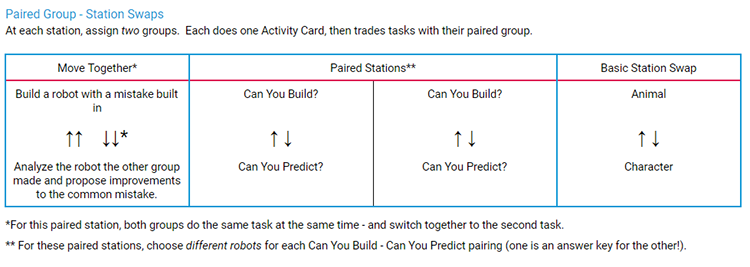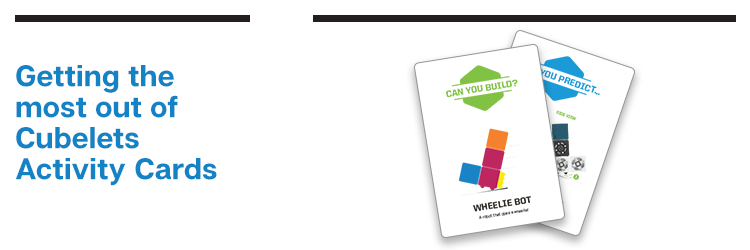Cubelets are useful in a variety of learning environments from open-play stations to whole-group guided release. But this balance between unstructured play (important!) and guided instruction (also important!) is a pendulum whose best practices are still not firmly agreed-upon by education researchers, so many teachers like to create their own middle ground. This often involves a workshop model of sorts, which we’ve talked about in previous #CubeletsChat posts. Today, I want to go more in-depth about using the Activity Cards we created, if Workshop Model describes your classroom.
Each Activity Card is double-sided. On the front, we always have an image or icon to help students quickly identify what type of task they are being asked to do. We also have a title for the card and a super-brief description to make sure students have everything they need to understand the challenge. On the back, we have three different types of information. One is a complexity rating using both stars and our labeling. For Cubelets we label our levels as: Novice, Apprentice, Artisan, and Master. We also have set-up clues and helpful hints. If students are struggling to complete their activity from the front side alone, encourage them to read through our clues on the back to help them get over their hurdles.
Our Cubelets Activity Cards include several different types of challenges that push students into unique types of thinking.

 Can You Build?
Can You Build?
Can You Build? cards are the cards that everyone expects to see. They pose a specific challenge to students and often introduce creative robots that students may not have thought of on their own. These cards are an opportunity for students to practice inductive reasoning.
Can You Build? cards are also useful because they are scaffolded build challenges. The front of the card has a big title identifying the robot, a single-sentence description of the robot’s behavior, and even has a TOP SECRET picture on the front that shows one way to successfully build the robot (don’t tell your students – we did this for you!).
Can You Predict?
Can You Predict? cards are the inverse of the Can You Build? cards. They give students an opportunity to practice their deductive reasoning by looking at an image of a robot and predicting how that robot will behave. This takes all of the normal maker skills and flips them on their head. We love these cards specifically for that reason; interpreting and predicting behaviors is just as important as being able to create robots, and may provide inspiration for future builds!
Teacher note: It will be important to train students about your expectations for these cards. It is tempting to look at a picture of a robot and immediately build it before intuiting how it will behave. You might require students to submit their own written predictions (using words or pictures!) before they receive the Cubelets to build the robot if they have a hard time remembering the expectations for these cards.

Invent It!
Invent It! cards are also easy to understand. These cards anchor the design process into an authentic task, like escaping a dark room or solving a maze. Some of these cards may take longer than one workshop station for students to complete their design, so it may be helpful to train your students to draw models of their unfinished robots for the last 3 minutes of each workshop rotation so they can pick up where they left off the following day.

Think About It!
Think About It! cards represent more general activities. They encompass concepts like Confused Robots or Blind Directions. For instance, the Confused Robots cards give students the opportunity to practice giving and receiving constructive feedback, but in a safe environment. How have we created this safe environment? We ask the students to make mistakes on purpose! By intentionally making mistakes, students get familiar with common bugs, prepare to debug their classmates’ buggy bots and are rewarded for providing helpful, constructive feedback.
So how might these Activity Cards fit into your classroom? Which cards go together? Which ones build on common skills? Here is my recommendation:
If students are rotating through multiple, unique stations:

If students are flip-flopping two stations during one class period:

And if you are looking for some sentence stems to support your students, take a peek at these!

Enjoyed this blog post? Sign up for the #CubeletsChat newsletter to receive the next blog post straight to your inbox. Plus join the discussion on twitter using the #CubeletsChat hashtag!



